Understanding the Wavelengths: 1064 nm vs. 532 nm in Ciellulu Liffan Q6

Understanding the Wavelengths: 1064 nm vs. 532 nm in Ciellulu Liffan Q6
Title: Understanding the Wavelengths: 1064 nm vs. 532 nm in Ciellulu Liffan Q6
The field of laser technology has seen significant evolution, opening up a multitude of possibilities in the medical sphere. As doctors, understanding these technological intricacies is paramount in maximizing treatment efficiency. A model worth noting for its ground-breaking duality in terms of wavelengths is the Ciellulu Liffan Q6, which utilises a Q-Switched Nd:yag laser. This article aims to delve into the scientific understanding of the 1064 nm and 532 nm wavelengths, their applications and when best to utilize them, as well as the clinical research that supports their efficacy.
The Science of 1064 nm Wavelength for Deeper Pigment
The Liffan Q6 utilizes a 1064 nm wavelength, setting it apart in the industry. This wavelength is particularly advantageous when targeting and treating more profound pigments, as it allows for optimal penetration into the dermis. The 1064 nm wavelength, due to its lower absorption by melanin, can bypass the epidermis and reach deeper-lying pigmented lesions. Therefore, it can be highly effective for the treatment of dermal pigmented lesions and deeper tissue structures.
Q6 Pigmentation Removal
The 532 nm Wavelength for Superficial Lesions
In contrast, the 532 nm wavelength is best suited to treat superficial pigmented lesions. Unlike the 1064 nm wavelength, it is highly absorbed by blood and melanin, thus lending itself effective in treating superficial structures such as epidermal pigmented lesions. Therefore, the 532 nm wavelength uniquely positions the Ciellulu Liffan Q6 to address a broad range of conditions, both on the surface and more profound into the dermis.
How Dual Wavelengths Enhance Treatment Versatility
The innovative integration of dual wavelengths in the Q6 unit significantly enhances its treatment versatility. The 532 nm and 1064 nm wavelengths collectively confer the capability to treat a wider array of conditions, from superficial to deep lying ones. More so, the capacity to interchange between wavelengths allows an optimal bespoke treatment approach, tailoring to the specific needs of each patient.
When to Use Each Wavelength
Deciding when to apply each wavelength depends on the condition and the depth of the target tissues. For deeper pigmentations and lesions such as tattoos, birthmarks, and certain types of vascular lesions, the 1064 nm wavelength is preferred. Conversely, for surface-level skin conditions including sun spots, discoloration and certain types of vascular lesions, the 532 nm wavelength is optimal.
Clinical Research Supporting Wavelength Efficacy
Numerous clinical studies support the efficacy of the 1064 nm and 532 nm wavelengths in the Q-Switched Nd:yag laser in treating various skin conditions. According to research outlined on the Ciellulu official website, several clinical trials have highlighted the efficacy of these wavelengths in achieving substantial improvements in patients. Therefore, the Ciellulu Liffan Q6's dual-wavelength system offers a highly effective, versatile and research-backed solution for pigment and vascular lesion treatment.
In light of the advanced dual-wavelength system of the Ciellulu Liffan Q6, it shows promise in enhancing treatment versatility. It blends the capabilities to treat both superficial and deeper lying conditions while optimizing patient-specific treatment approaches. With robust clinical research supporting its efficacy, it proves to be a game-changer for clinicians globally.
Source: Understanding the Wavelengths: 1064 nm vs. 532 nm in Ciellulu Liffan Q6




 Ciellulu Laser - Facial Machine Supplier
Ciellulu Laser - Facial Machine Supplier

